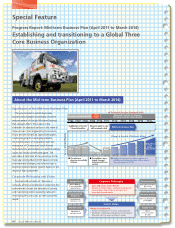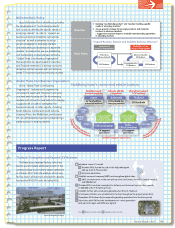Isuzu 2013 Annual Report Download - page 20
Download and view the complete annual report
Please find page 20 of the 2013 Isuzu annual report below. You can navigate through the pages in the report by either clicking on the pages listed below, or by using the keyword search tool below to find specific information within the annual report.
18
Isuzu Motors Limited
Financial Section
net cash of ¥57.4 billion used in investing activities, principally
capital expenditure, and net cash of ¥72.1 billion used in financing
activities, principally repayment of interest-bearing debt.
Free cash flow, calculated by subtracting cash flow provided by
investing activities from cash flow provided by operating activities,
resulted in a net cash inflow of ¥79.6 billion (up 78.1% from the
previous year).
Cash flow from operating activities
Cash flow from operating activities rose 72.4% to ¥137.1 billion
from the previous year.
Net cash inflows of ¥138.2 billion from the effects of
accounting for income before income taxes and majority interests
and ¥35.6 billion from depreciation and amortization offset
net cash outflows of ¥23.8 billion stemming from a decline in
accounts payable.
Cash flow from investing activities
Net cash used in investing activities increased 65.2% to ¥57.4
billion due primarily to an increase in expenditures associated with
the purchase of fixed assets
Cash flow from financing activities
Net cash used in financing activities fell 13.0% to ¥72.1 billion.
The change was due primarily to the Group’s repayment of
interest-bearing debt.
2. Assets
As of March 31, 2013, combined consolidated assets totaled
¥1,340.8 billion, an increase of ¥127.4 billion from the previous
year.
The figure includes increases of ¥24.2 billion in cash and time
deposits; ¥21.9 billion in notes and accounts receivable; ¥21.4
billion in inventory assets; ¥24.8 billion in property, plant and
equipment; and ¥18.6 billion in investments.
3. Liabilities
Total liabilities at March 31, 2013, fell ¥13.8 billion from the
previous year to ¥719.8 billion.
A decline in interest-bearing debt of ¥59.4 billion due to steady
repayment of loans offset an increase of ¥23.3 billion in accrued
income taxes.
4. Net assets
Net assets increased ¥141.3 billion in fiscal 2013 to ¥620.9
billion.
Net income of ¥96.5 billion combined with increases of ¥26.0
billion in the foreign currency translation adjustments account,
¥3.0 billion in unrealized holding gain on securities, and ¥27.8
billion in minority interest due to an increase in net assets held
by subsidiaries, offsetting a reduction of ¥11.8 billion in retained
earnings due to dividend payments.
As a result, Isuzu’s equity ratio improved 5.3 points from a year
earlier to 39.5%.
Risks
There are certain risks that could have a significant impact on
our earnings results, financial condition, and other information
contained in the annual securities report, or share prices, and
these risks are outlined below. (The following information
includes forward-looking statements that reflect the judgment of
management as of June 27, 2013).
1. Economic situation/supply and demand trends in Isuzu’s
major markets
Vehicles account for an important portion of the Isuzu Group’s
worldwide operating revenue, and demand for these vehicles is
affected by the economic situation in the various countries and
regions where Isuzu sells vehicles. Therefore, economic recession
and an ensuing decline in demand in the Group’s major markets—
Japan, North America, and other Asian countries—could have
a negative impact on the Group’s performance and financial
position. Price competition also entails the risk of price fluctuation
for Isuzu products.
2. Interest rate fluctuations
The Isuzu Group is working to tighten its cash flow
management and shrink interest-bearing debt. During the fiscal
year under review, the interest-bearing debt balance fell ¥59.4
billion compared to the previous fiscal year to ¥143.6 billion (as
of March 31, 2013). Concerning the cost of financing, the Group
remains vulnerable to the risk of higher interest payments having a
negative impact on its performance and financial position should
market rates rise sharply.
3. Foreign exchange fluctuations
The business of the Isuzu Group includes the manufacture
and sale of products in several regions around the world. Local
currency amounts for sales, expenses, assets, and other items
are therefore converted into Japanese yen in the preparation
of Isuzu’s consolidated financial statements. Depending on the
exchange rate in effect at the time of conversion, the yen amount
for these items may change even if the underlying currency
value has not changed. Moreover, because foreign exchange
fluctuations influence the prices paid by the Group for raw
materials denominated in foreign currencies as well as the pricing
of the products the Group sells, they may have a negative impact
on the Group’s performance and financial position. Generally,
a strengthening of the yen relative to other currencies has a
negative impact on the Group’s business, and a weakening of the
yen has a positive impact.
4. Dependence on major customers
The Isuzu Group supplies vehicle components to General
Motors Corporation (Detroit, MI) and its affiliates as well as
to other vehicle manufacturers. Sales to these customers are
affected by fluctuations in production and sales at these customer
companies and other factors over which the Isuzu Group has no
control, and therefore they could have a negative impact on the
Group’s performance and financial position.
























